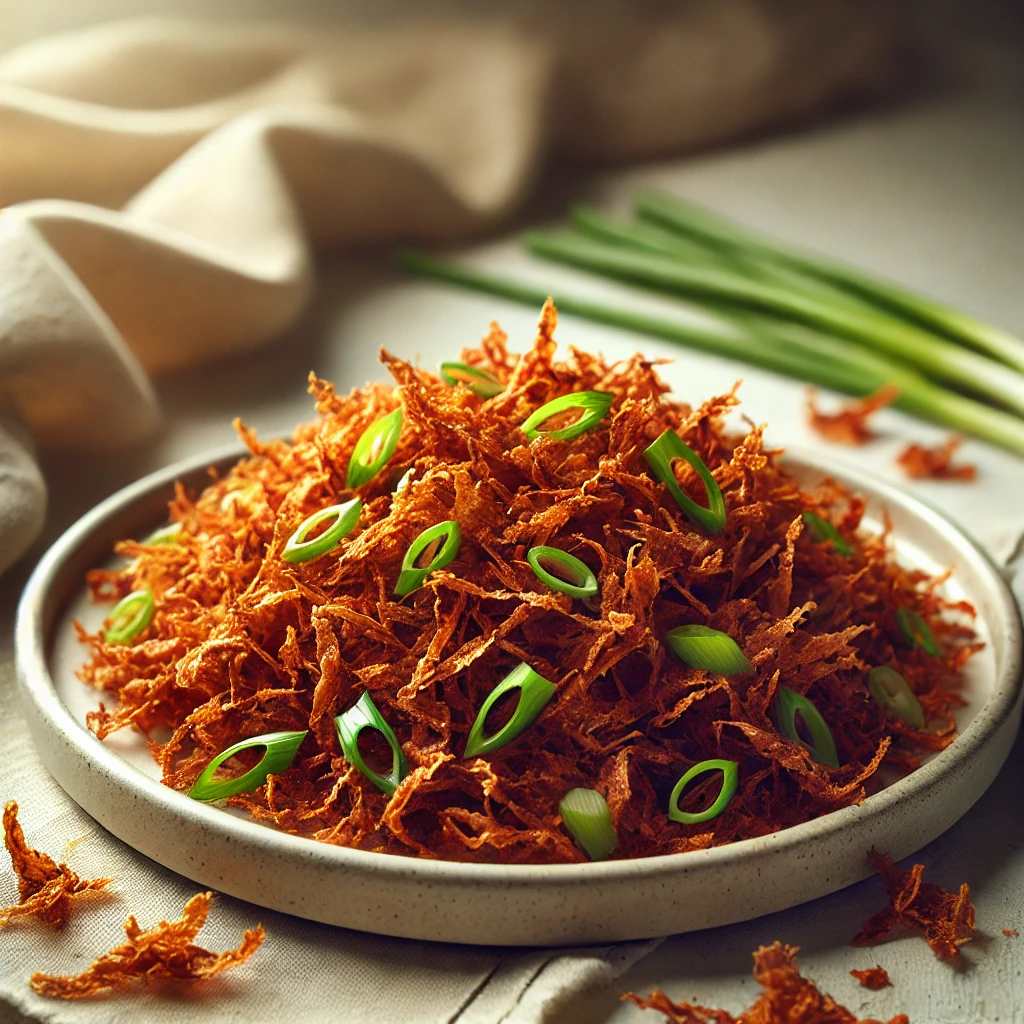Have you ever found yourself craving the rich, savory flavors of Filipino adobo, but didn’t have the time or energy to cook a full batch? Enter adobo flakes – the perfect solution for busy food lovers who want to enjoy this iconic dish without the fuss. As a Filipino-American chef, I’ve spent years perfecting my adobo recipe, and I’m excited to share this innovative twist that transforms leftover adobo into a versatile, crave-worthy ingredient.
Adobo flakes take the classic Filipino dish to new heights by shredding and crisping the meat, concentrating its flavors and creating a delightful texture that’s both crunchy and tender. This preparation method not only breathes new life into leftover adobo but also opens up a world of culinary possibilities. Whether you’re sprinkling it over rice, stuffing it into sandwiches, or using it as a topping for salads, adobo flakes offer a convenient and delicious way to incorporate the beloved flavors of adobo into your daily meals.
What makes adobo flakes truly special is their ability to capture the essence of traditional adobo – that perfect balance of soy sauce, vinegar, garlic, and bay leaves – in a form that’s incredibly versatile and easy to use. Plus, this recipe is naturally gluten-free and can be adapted for various dietary needs, making it an inclusive option for diverse palates and preferences.
Recipe Ingredients
Let’s dive into the ingredients you’ll need to create these mouthwatering adobo flakes. The beauty of this recipe lies in its simplicity – you’ll likely have most of these items in your pantry already.
| Ingredient | Quantity | Notes |
|---|---|---|
| Leftover adobo (pork or chicken) | 2 cups | Shredded |
| Vegetable oil | 2 tablespoons | For frying |
| Garlic cloves | 3-4 | Minced |
| Bay leaves | 2 | Crumbled (optional) |
| Black pepper | 1/4 teaspoon | Freshly ground |
| Brown sugar | 1 teaspoon | Optional, for added caramelization |
Substitution suggestions:
- If you don’t have leftover adobo, you can quickly prepare a basic adobo using 1 pound of chicken or pork, 1/4 cup soy sauce, 1/4 cup vinegar, 4 cloves of garlic, and 2 bay leaves. Simmer until the meat is tender before proceeding with the flaking process.
- For a healthier option, you can use olive oil instead of vegetable oil.
- If you’re watching your sodium intake, you can reduce or omit the additional soy sauce often used in the flaking process, as the leftover adobo already contains enough flavor.
Recipe Instructions
Now that we have our ingredients ready, let’s walk through the process of creating these delectable adobo flakes. Follow these steps carefully, and you’ll be rewarded with a batch of crispy, flavorful goodness that will elevate any meal.
- Prepare the leftover adobo:
- If your leftover adobo is cold from the refrigerator, allow it to come to room temperature for about 15-20 minutes.
- Using two forks or your hands, shred the adobo meat into small, bite-sized pieces. Set aside.
- Heat the pan:
- Place a large skillet or wok over medium-high heat.
- Add the vegetable oil and allow it to heat up until shimmering.
- Fry the garlic:
- Add the minced garlic to the hot oil.
- Stir constantly for about 30 seconds or until the garlic becomes fragrant and lightly golden. Be careful not to burn it.
- Add the shredded adobo:
- Carefully add the shredded adobo to the pan with the garlic.
- Spread the meat evenly across the surface of the pan to ensure even cooking.
- Cook and crisp the adobo:
- Allow the adobo to cook undisturbed for 2-3 minutes until the bottom layer starts to crisp.
- Using a spatula, flip and stir the meat to expose uncooked portions to the heat.
- Continue this process for about 10-15 minutes, or until the adobo flakes reach your desired level of crispiness.
- Season and finish:
- Sprinkle the crumbled bay leaves (if using) and freshly ground black pepper over the adobo flakes.
- If desired, add the brown sugar at this point for a touch of sweetness and extra caramelization.
- Stir well to incorporate the seasonings and cook for an additional 1-2 minutes.
- Drain and cool:
- Remove the adobo flakes from the heat and transfer them to a plate lined with paper towels to absorb any excess oil.
- Allow the flakes to cool slightly before serving or storing.
Helpful tips:
- For extra crispy flakes, you can spread the cooked adobo on a baking sheet and place it under the broiler for 2-3 minutes, watching closely to prevent burning.
- If the pan becomes too dry during cooking, you can add a small amount of the leftover adobo sauce to moisten the meat and intensify the flavor.
- For a healthier version, you can air fry the shredded adobo at 375°F (190°C) for 10-15 minutes, shaking the basket every 5 minutes for even crisping.
Recipe Tips & Variations
Now that you’ve mastered the basic adobo flakes recipe, let’s explore some tips and variations to help you customize this versatile dish to your liking:
Tips for success:
- Use a non-stick pan to prevent the meat from sticking and ensure easy flipping.
- Don’t overcrowd the pan – cook in batches if necessary to achieve optimal crispiness.
- Store leftover adobo flakes in an airtight container in the refrigerator for up to 3 days. Reheat in a dry skillet over medium heat to restore crispness.
Variations:
- Spicy Adobo Flakes: Add 1-2 chopped bird’s eye chilies or a pinch of red pepper flakes during the cooking process for a spicy kick.
- Adobo Flakes with Onions: Sauté thinly sliced onions until caramelized before adding the shredded adobo for added sweetness and texture.
- Coconut Adobo Flakes: Sprinkle 2 tablespoons of unsweetened coconut flakes over the adobo during the last 2-3 minutes of cooking for a tropical twist.
- Adobo Flakes Fried Rice: Use the crispy adobo flakes as a protein-packed topping for your favorite fried rice recipe.
Storage instructions:
To maintain the crispiness of your adobo flakes, store them in an airtight container with a piece of paper towel to absorb any excess moisture. When properly stored in the refrigerator, they should last for 3-4 days. For longer storage, you can freeze the adobo flakes for up to 1 month. To reheat, simply warm them in a dry skillet over medium heat until crispy again.
Nutritional Information
While the exact nutritional content may vary depending on the specific adobo recipe used and the cooking method, here’s an approximate nutritional breakdown for a 1/2 cup serving of adobo flakes:
| Nutrient | Amount |
|---|---|
| Calories | 250-300 |
| Protein | 20-25g |
| Fat | 15-20g |
| Carbohydrates | 5-10g |
| Sodium | 600-800mg |
| Fiber | 0-1g |
Please note that these values are estimates and may vary based on the specific ingredients and proportions used in your adobo recipe.
As I sit here, savoring a bowl of steaming rice topped with crispy adobo flakes, I’m reminded of the countless family dinners where adobo took center stage. This dish has always been more than just a meal in Filipino culture – it’s a symbol of love, comfort, and tradition. By transforming leftover adobo into these delicious flakes, we’re not only reducing food waste but also paying homage to the ingenuity of Filipino cooking, where no ingredient goes to waste and every dish tells a story.
I encourage you to try this adobo flakes recipe and experience the joy of rediscovering a classic dish in a new form. Whether you’re a long-time fan of Filipino cuisine or new to the flavors of adobo, I’m confident you’ll find these crispy, savory flakes irresistible. Don’t be afraid to experiment with different variations and find your perfect way to enjoy them.
If you give this recipe a try, I’d love to hear about your experience! Share your thoughts, photos, and any creative ways you’ve incorporated adobo flakes into your meals. And if you’re hungry for more Filipino-inspired recipes, be sure to check out my blog for a wide range of dishes that celebrate the rich culinary heritage of the Philippines.
Happy cooking, and may your kitchen always be filled with the mouthwatering aroma of adobo!
Additional Elements
Related recipes and pairings:
- Classic Filipino Garlic Fried Rice (Sinangag)
- Pickled Green Papaya (Atchara) – a perfect tangy side dish to complement the rich adobo flakes
- Filipino Tomato and Onion Salad (Ensaladang Kamatis)
Serving suggestions:
- Serve adobo flakes over steamed white rice for a classic Filipino meal
- Use as a filling for tacos or burritos for a fusion twist
- Top a crisp green salad with adobo flakes for a protein-packed lunch
- Stuff into sandwiches or panini for a flavorful upgrade to your usual lunchtime routine
Equipment recommendations:
- A large, heavy-bottomed skillet or wok for even heat distribution
- A sturdy spatula or wooden spoon for stirring and flipping
- An airtight container for storing leftover adobo flakes
Historical context:
Adobo, the dish from which adobo flakes are derived, has a rich history in Filipino cuisine. The method of cooking meat in vinegar and spices was a traditional preservation technique used long before the arrival of Spanish colonizers. The term “adobo” was later applied by the Spanish to describe this cooking method, which reminded them of their own adobo preparations. Over time, adobo evolved to incorporate soy sauce, introduced by Chinese traders, creating the beloved dish we know today. The creation of adobo flakes represents a modern innovation, reflecting the Filipino penchant for reinventing and maximizing the use of leftover dishes.
Disclaimer: This recipe blog post is based on information available up to 2019. While we strive for accuracy, culinary trends and nutritional understanding may have evolved since then. Please consult current sources for the most up-to-date information on ingredients, cooking methods, and dietary considerations. If you notice any inaccuracies in this post, please report them so we can promptly make corrections.




